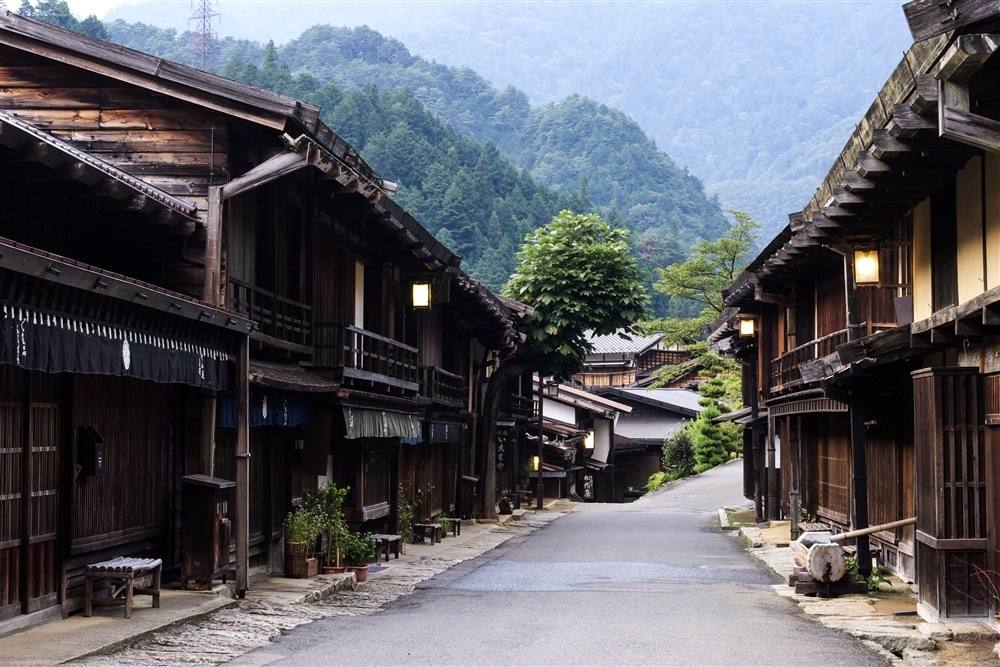
Day 1
A few hours by express train brings you to Narai-juku, the second of Kisoji’s post towns and Nakasendo’s midpoint. As travelers have done for centuries past, set out on foot along the main street, which is lined on both sides with delightfully preserved Edo-era houses. Note the overhanging second-floor galleries and eaves, which are features peculiar to Narai-juku.
Lunch is best savored in one of the many small eateries, all of which ooze rustic charm. Homemade soba noodles are a staple here. Served hot or chilled with side dishes or in a broth of chopped vegetables and tofu known as sottaku doji, they provide a hearty filler for the day. For less vigorous appetites, there are wild vegetable buns and gohei rice cake, a local specialty rice ball seasoned with sesame and miso.
Spend the afternoon wandering the high street and its narrow alleyways. There are a number of fascinating boutique museums, including one housed in the former home of a wealthy merchant. Narai-juku excels in knickknack stores, most of which offer a generous selection of locally produced japan lacquerware. Browse judiciously to find the quintessential bowl or set of chopsticks.
Board a local train to Kiso-Fukushima, a few stops down the line, and check in to your lodgings for the night. Although officially a town, Kiso is listed as one of “the most beautiful villages in Japan.” An evening stroll before dinner provides an opportune moment to put this claim to the test.
Day 2
After breakfast, take the short train ride across the prefectural border to Nakatsugawa. Before heading to the Magome trailhead by private vehicle, make a brief stop at Zenagi, where you’ll be staying for the night.
The eight-kilometer-long Magome-Tsumago trail is a relatively gentle and highly enjoyable way to spend two to three hours in Kiso Valley. The leisurely hike takes you through forest and open countryside as well as past the homes and fields of the local inhabitants.
At the halfway point, stop for a well deserved breather at a traditional-style house offering hikers snacks and green tea. Be sure to leave a donation.
Your private vehicle is waiting at Tsumago to ferry you back to Zenagi, a renovated traditional farmhouse perched upon a hill and surrounded by stone walls. Before dinner, soothe your aching muscles in a hinoki bathtub. The scent of the cypress wood is said to promote blood circulation and relax the body.
Cuisine at Zenagi is a reflection of the hotel’s charmed location. Mushrooms fresh from the forest, wild game (bear, boar and deer meat) from the mountains, organic vegetables from the villages and seafood from Ise Bay are melded together by world-renowned chefs to produce what Zenagi has dubbed “Kiso Slow Food.”
Day 3
The pace at Zenagi is in keeping with the slow food and rustic ataraxia. There is no hurry. Wake up late to the aroma of a Japanese–style breakfast being prepared. Feel free to wander from room to room, gliding across floors finished with ebony lacquer below high ceilings blackened by centuries of wood smoke. Adroitly ornamented with locally made objets d’art, Zenagi is an artwork in itself.
When it is finally time to leave, return to Nakatsugawa Station by private vehicle and board a train to Nagoya. From there continue on to Tokyo or Kyoto by Shinkansen bullet train.
In the Edo era (1603-1868) Nakasendo (lit. “central mountain route”) was one of a number of formal trade routes developed to connect Kyoto with Edo, as Tokyo was then called. Part of this route stretches from Niekawa-juku in Nagano Prefecture to Magome-juku in neighboring Gifu. Known as Kisoji, this much older trail strings together eleven rest stations (or post towns) that today are much visited for their old-world ambience and mountain vistas.